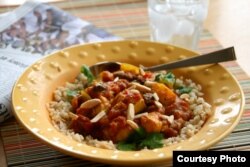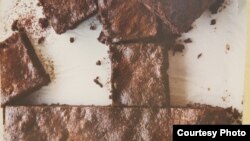People have long known about the importance of food in promoting good health. The ancient Greek physician Hippocrates, the father of Western medicine, said, "Let food be thy medicine and medicine be thy food."
Today’s research confirms that certain foods have the potential to cure, prevent or aggravate diseases. That’s the focus of The Anti Inflammation Cookbook by chef Amanda Haas.
To understand why we should avoid inflammation, we need to understand what it is. Neil Bernard, associate professor of medicine at George Washington University's medical school, said inflammation is a natural response of our immune system.
“It’s our body’s way of attacking invaders," he said. "So if bacteria or viruses enter the body, inflammation is a way of knocking them out.”
However, inflammation can also contribute to illness, from asthma and arthritis to cancer and diabetes. When inflammation becomes chronic, the body turns against its own tissue.
“It’s a biological equivalent of friendly fire,” Bernard said. “For example, in rheumatoid arthritis, the joints are inflamed, and that’s not a bacterium that’s being attacked, it’s the lining of our joint. That’s when the inflammation becomes a problem.”
All in the kitchen
Haas suffered from rheumatoid arthritis, as well as "things like chronic heartburn and stomach pain, back problems."
"I had an allergist who said to me, ‘Amanda, these are just all different forms of inflammation in your body. I think it’s something that you’re eating. Since you cook for a living, why don’t you go and figure out what’s going to make you feel great and share it with other people?’ ”
Haas examined ingredients she often used in her recipes, “things we all probably know we shouldn’t have too much of — things like refined sugars, too much caffeine,” she said. “A lot of people [know that] if you have joint and arthritic issues, you can be sensitive to peppers and eggplants and tomatoes.
"I had too much to work with. I wanted people to understand that eating an anti-inflammatory diet can be delicious [but] you’re going to be using a lot of green, leafy vegetables," she said. "I use a lot of spices, fresh herbs as well. You’ll see me use a lot of citrus and natural sweeteners, like a little bit of honey, maple syrup. You wouldn’t see me using a lot of refined sugar at all.”
All kinds of recipes
In The Anti-Inflammation Cookbook, Haas shares lots of vegan recipes, along with others that use animal protein.
“Even though most people who are trying to eat an anti-inflammatory diet will not eat a lot of animal protein, I wanted to explain which types to buy and why they can be good to you in small amounts as well,” she said. “I learned so much about grass-fed beef. The thing that’s fascinating is that if cattle are grass-fed, the meat has a lot of the omega-3 and omega-6 fatty acids that we find in salmon and other oily fish that are good for us. Most doctors would say 4-ounce portions or less [of animal protein] can really be a great part of an anti-inflammatory diet.”
Country Captain’s Chicken — with lots of curry and turmeric — is one of the author's favorite recipes.
“This is a dish my grandmother used to make for me,” she said. “It was created by people who settled in that Charleston-Savannah area, in Sorth Carolina — people from India, Asia and French descents. All you do is put some olive oil in a pan. You brown the chicken. Then you take out the chicken and you put in all of the other ingredients that you want to cook down — onion and celery, and then add the curry powder and black pepper.
"One little thing to know that’s interesting is that turmeric is well-known for being the anti-inflammatory [spice], but to increase the bioavailability of it, add black pepper," she added. "Then add some tomato paste and some tomatoes with their juices and raisins, and you simmer all that. Put the chicken back in the pot and let it cook for about 45 minutes.”
For VOA's international audience, Haas recommended Chocolate Coconut Brownies.
“They have coconut oil in them as a fat source," she said. "We thought coconut oil was bad for us, but that’s because it was so refined. Now we’re finding out that good coconut oil can potentially lower our cholesterol. So they’re just these amazing brownies that have the most incredible texture with the coconut oil in them.”
Food is your medicine
Bernard is happy to see more people becoming aware of importance of healthy eating.
“We always favor a vegan diet, plant-based diet. We want to emphasize some of these food as healthy — nuts or seeds — and getting away of greasy stuff," he said. "Unfortunately, the medical world tends to rely on prescriptions, and we sometimes neglect things that can be more natural, safer and, in the long run, more effective.”
The Anti-Inflammation Cookbook is a 21st-century take on that ancient advice: Let food be your medicine.
Recipes:
CHOCOLATE-COCONUT BROWNIES
½ cup (80 g) gluten-free flour
¼ cup (30g) unsweetened alkalized cocoa powder
½ tsp sea salt
4 oz (115 g) semisweet chocolate, coarsely chopped
¾ cup (120 g) unrefined coconut oil
1 cup (200 g) raw cane sugar
4 eggs
1 tsp vanilla
4 oz (115 g) semisweet chocolate chips (optional)
Preheat the oven to 350 F (180 C). Grease a 9-by-9-in. (23-by-23-cm) pan and line with parchment paper. Combine the flour, cocoa powder and salt in a medium bowl. Set aside. In a double boiler or microwave, melt the chopped chocolate and coconut oil. Let cool slightly. Add the sugar, eggs, and vanilla, whisking until well-combined. Wisk in the flour mixture. Fold in the chocolate chips (if using). Pour into the prepared pan. Bake until a toothpick inserted in the brownies comes out clean — 20 to 25 minutes.
This will yield a somewhat gooey brownie. Continue to bake for 5 to 10 minutes if you prefer a drier brownie.
Let brownies cool completely, then cut into squares. Store in an airtight container at room temperature for up to three days.
QUINOA SALAD
6 cups (850 g) cooked rainbow, white or red quinoa, cooled
½ cup (120 g) garlic-lemon vinaigrette
½ cup (80 g) currants
½ cup (50 g) thinly sliced green onions, white and light green parts only
5 radishes, thinly sliced
2 carrots, peeled and cut into ¼-in (6mm) matchsticks
3 tbsp finely chopped mint
1 tbsp lemon juice
½ cup (70 g) toasted pine nuts or cashews
Kosher salt
Freshly ground black pepper
Combine the quinoa with 1/3 cup (80 g) of the vinaigrette in a large bowl. Add the currants, green onions, radishes, carrots, mint and pine nuts, and mix with a spoon. Taste, adding up to ½ tsp salt and fresh grinding of pepper.
The salad can be held at room temperature for up to six hours. Before serving, stir in the remaining vinaigrette.








